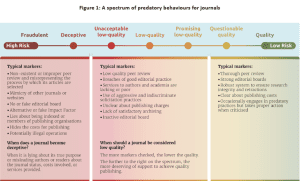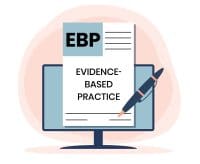A new international report on predatory journals tells an alarming tale—the organizations behind these journals are becoming more sophisticated, making detection more difficult for authors. In addition, the number of these journals is now estimated to be over 15,500, based on data from Cabells Predatory Reports.
Publication of poor or misleading research can lead to a number of negative effects, including poor decision making related to patient care and healthcare policy. At the individual level, publishing in a predatory journal can damage your career.
Here’s a brief overview of the report, Combatting Predatory Academic Journals and Conferences, from the InterAcademy Partnership (IAP), a global network of more than 140 science, engineering, and medical academies. The report provides information about a 2-year study designed to identify interventions that can combat the rise in predatory journals and conferences. (Here I’ll focus on journals.) The report’s working group conducted an extensive literature review and gathered perspectives from practitioners around the world.
What’s a predatory journal?
In 2019, Grudniewicz and colleagues published a consensus definition of predatory journals: “Predatory journals and publishers are entities that prioritize self-interest at the expense of scholarship and are characterized by false or misleading information, deviation from best editorial and publication practices, a lack of transparency, and/or the use of aggressive and indiscriminate solicitation practices.”
The key point is that publishers prioritize their own interests over sound scholarship. The IAP report notes that poor publishing practices associated with predatory journals “can be committed by new and established, fraudulent and reputable, traditional and open access publishers, anywhere in the world.” Because these practices can occur in many types of journals, answering the question, “Is this a predatory journal?” with a simple yes or no means that authors could think a journal is high quality even when it’s engaging in poor publication behaviors.
The IAP report recognizes the complexity of evaluating journal practices by suggesting that journals should be evaluated using a spectrum approach.
A spectrum approach
The spectrum approach makes it easier for authors to identify poor publishing behaviors, even if the journal isn’t defined by a “watch” list as being “predatory.” The spectrum in the IAP report ranges from high-risk to low-risk predatory behaviors, with the following categories listed (in order of high- to low-risk): fraudulent, deceptive, unacceptable low-quality, low-quality, promising low-quality, questionable quality, and quality.
The spectrum provides markers that indicate deception, low quality, and quality journals. For example:
- Typical markers for a deceptive journal include no (or a fake) editorial board and no (or low-quality) peer review.
- Typical markers for a low-quality journal include lack of clarity about publishing charges and an inactive editorial board.
- Typical markers for a quality journal include thorough peer review and a robust system to ensure research integrity and retractions.
It’s worth taking a few minutes to carefully review the spectrum (see below), including the markers. It’s Figure 1 in report summary, which you can download for free.


Recommendations
The IAP report details several recommendations for addressing the problem of predatory journals. Here are a few related to the research community, which includes authors, supervisors, and mentors:
- Do not rely on imperfect “watch” and “safe” lists of predatory journals; use the markers in the spectrum to help choose appropriate journals.
- Verify any claims by a journal that it’s listed in a reputable index, such as Scopus or Web of Science, by checking the index itself. (I would add the Nursing Journal Directory from the International Academy of Nursing Editors; the journals have been vetted by professional nurse editors.)
- Stop knowingly publishing in or citing predatory journals.
- Familiarize yourself with good peer-review practices and serve as a peer reviewer.
- Actively participate in committees and other platforms to advocate for quality-not-quantity evaluation.
Other recommendations target universities, academies, research funders, libraries and indexing services, and publishers.
Consider carefully
The best journals to publish in are the ones you and your colleagues read, respect, and cite, such as those associated with well-known professional nursing associations. However, sometimes your topic calls for a different publication outlet. In that case, the spectrum presented by the IAP report can be a valuable tool to help you choose wisely among your publication options.
I also encourage you to read the report for its many suggestions about how to address the issue of predatory journals on a broader scale, such as focusing on quality and not quantity when evaluating someone for career advancement and research grant applications.
References
Grudniewicz A, Moher D, Cobey KD, et al. Predatory journals: No definition, no defence. Nature. December 11, 2019. nature.com/articles/d41586-019-03759-y
InterAcademy Partnership. Combatting Predatory Academic Journals and Conferences. Summary Report. March 2022. interacademies.org/publication/predatory-practices-summary-English
Saver C. How to select and query a publication. In: Saver C. Anatomy of Writing for Publication for Nurses. 4th ed. Indianapolis, IN: Sigma Theta Tau International; 2021; 31-47.
Numbers from the Combatting Predatory Academic Journals and Conferences report
More than 1,800 from 112 countries responded to the survey.
- Over 80% of respondents indicated that predatory journals and conferences are already a serious problem or on the rise in their country.
- In all, 14% had published in a predatory journal or participated in a predatory conference, mostly because they were unaware or they needed to advance their career; another 10% didn’t know if they had. The report notes that 14% equals over 1.2 million researchers.
 Hi, I’m Cynthia Saver, MS, RN, president of CLS Development, Inc., which provides writing and editing services, and editor of Anatomy of Writing for Publication for Nurses, 4th ed. I’m also past editorial director for American Nurse Journal.
Hi, I’m Cynthia Saver, MS, RN, president of CLS Development, Inc., which provides writing and editing services, and editor of Anatomy of Writing for Publication for Nurses, 4th ed. I’m also past editorial director for American Nurse Journal.
I’ve been a full-time professional nurse writer and editor for many years, and that doesn’t count the writing I did as I fulfilled my nursing roles in clinical, research, education, and management. My passion is helping nurses share their expertise through the written word, including, but not limited to, publication. Writing can be scary and intimidating. I hope to make it less so and to help you develop your writing skills the same way you’ve developed your nursing skills.
Whether you’re considering your first or your 50th publication, want to contribute to your organization’s newsletter, or crave to be a better communicator online and in print, I hope you’ll find what I write helpful. The nurse publishing colleagues I’ve learned from over the years (many of whom are contributors to my book) may not be listed by name, but I’m grateful for their willingness to share. In that spirit, I’m looking forward to sharing with you! If you have feedback, feel free to email me at csaver57@gmail.com.



















